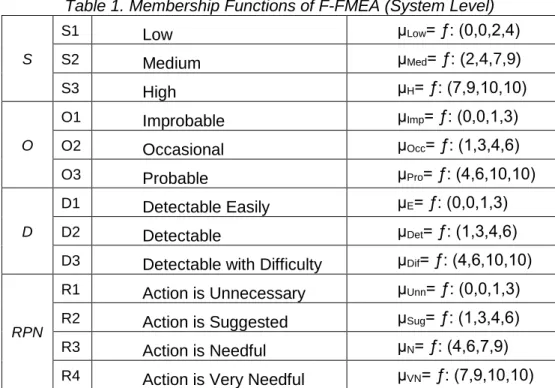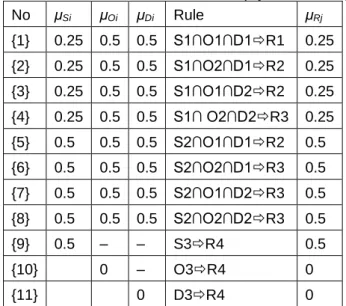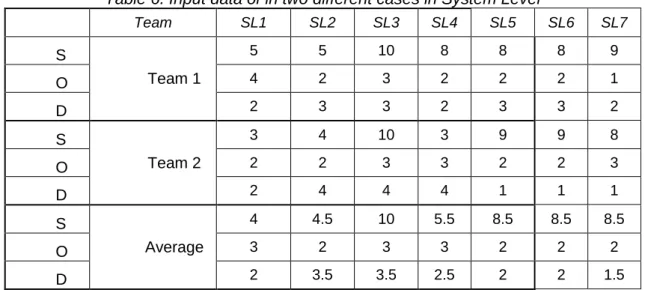ADVANCED FUZZY RULE-BASED FAILURE MODE AND EFFECT ANALYSIS
Sinan Koçak 1*, László Pokorádi 2 and Edit Tóth-Laufer 2
1 Doctoral School on Safety and Security Sciences, Óbuda University, Népszínház u. 8. Budapest, Hungary
2 Institute of Mechatronics and Vehicle Engineering, Óbuda University, Népszínház u. 8. Budapest, Hungary https://doi.org/10.47833/2021.3.ENG.001
Keywords:
FMEA; hierarchical approach;
fuzzy approach; layer-specific evaluation; summative defuzzification
Article history:
Received 30 Oct 2021 Revised 10 Nov 2021 Accepted 21 Nov 2021
Abstract
This article aims to show few advanced approach method for improving Failure Mode and Effect Analysis (FMEA). The possible failure situations in the system and design are investigated separately and considered in a Hierarchical FMEA worksheet form. The authors propose three different methodological methods based on hybridized fuzzy logic and FMEA.
1 Introduction
Nowadays, automobiles are among the most important vehicles that people cannot give up on daily use. Especially in metropolitan cities, traveling from one place to another may take time by walking or using the public transportation system. Therefore, it would not be a mistake to say that every family or tradesman's first investment tool will be an automobile. As the car population increases, many accidents occur because of human mistakes. However, vehicle-designed systems of safety, reliability, and intelligence can minimize most car crashes. Many experiences indicate in the automotive industry signifies those defects, failures, and accidents happen in this field when designed products, functions, systems, or processes are built fast and without respect for cost- effectiveness. Therefore, automotive manufacturers must analyze the reliability of each part of the design and system in the vehicles they produce. Hence, quality control, a significant area of production and development management, is indispensable. Fuzzy-based FMEA predictive qualitative models can prevent failure at any stage of vehicle function without causing much bigger problems.
The Failure Mode and Effect Analysis (FMEA) is a well-known “bottom-up” reliability analysis technique for identifying all possible failures essential in system, design, or process [1]. In the late 1940s, the US military introduced FMEA, which NASA used and implemented in the 1960s in the Aerospace industry during the Apollo mission, followed in the mid-1970s automotive sector by the Ford engine company [2].
The Fuzzy set concept was first introduced and published by Lotfi A. Zadeh in the mid-1960s to deal with mathematical models that are difficult to quantify [13]. The degree of membership ranges specified between 0 and 1 with this theorem, instead of the classical concept of sets 0 or 1 [4]. This approach has a more flexible structure, and it offers more realistic solutions to daily life problems. In the mid-1970s, Mamdani and Assilian first operated the fuzzy logic inference, which is well suited for dynamic modeling purposes of an expert application as it has more intuitive and understandable rules created by human experts [5]. Fuzzy logic in risk assessment has advantages when applied together with FMEA, improving quality, reliability, safety process, reducing uncertainties of human thinking.
This article aims to optimize the Ványi and Pokorádi [12] study on the classical FMEA method for vehicles Wheel Speed Sensor (WSS), considered separately in a hierarchical worksheet. The authors present three different mathematical models along with using fuzzy sets and fuzzy rules.
The paper's outline is organized as follows: Section 2 summarizes theoretically classical FMEA, Hierarchical FMEA (H-FMEA), Fuzzy approach for H-FMEA. Section 3 gives the effect of Fuzzy rule-based H-FMEA (FH-FMEA). Section 4 proposes the conditions of layer-specific FH- FMEA. Section 5 recommends the result of the summative defuzzification method. Finally, section 6 addresses the conclusion.
2 Theoretical background
2.1 Conventional Failure Mode and Effect Analysis
The standards and guidelines are declared in the automotive quality management systems that cover the general procedure for achieving an FMEA. For example, Society of Automotive Engineers (SAE) J1739, Alignment Automotive Industry Action Group (AIAG), and German Association of the Automotive Industry (VDA) [12].
The conventional FMEA classifies each failure mode based on its severity (S), occurrence (O), and detectability (D) with rating scales. These specific risk situations are rated form on their risk priority number (RPN), which follows
RPN S O D
(1)formula to calculate the failure mode [8].
The Relative RPN (Rel_RPN) is determined as
1
e _
ni
R l RPN RPN
RPN
(2)
where n is the number of failures.
2.2 Hierarchical Failure Mode and Effect Analysis
Individual levels of analysis, such as system, design, or process, are examined in conjunction with each other (as built on top of each other), using the Hierarchical FMEA (H-FMEA) form. Applying H-FMEA gives analysts a significant advantage as a catalog system that can be used for preliminary risk assessment of other vehicle systems evaluation in the future.
There are four stages in the H-FMEA, and the fuzzy approach is applied in two of them (SL, DL):
The first level, the Effect Level (EL), does not hold fully assessed risks. However, a list of potential failures in the entire system is classified here.
The System Level (SL) is dedicated to analyzing the origin of the failures in the entire system in connection with the hierarchical association of the failure conclusions.
From the Design Level (DL) to the Cause Level (CL), each of these failures reflects an equivalent risk ranking over the whole system.
Ványi [12] presented the Hierarchical Failure Mode and Effect Analysis (H-FMEA) technique concerning preliminary risk evaluation of a Wheel Speed Sensor (WSS).
In the automobile Anti-Block System (ABS), the WSS detects a particular wheel's condition.
Two main components - the magnetic sensor and cogwheel plate considered. The magnetic sensor attached to each tire of the vehicle works by sending a periodic signal depending on the rotation speed of the cogwheel plate.
Figure 2 presents the connections between the four levels. The highlighted 'No signal supplied' in the potential effect column is shown in the figure, and this information is passed from EL to SL as a severity ranking number.
Figure 2. Top to Bottom Effect Linking [6]
2.3 Fuzzy Approach
The fuzzy modeling or inference system bypasses the input data in several stages and transforms them into output data. A considered Fuzzy inference system follows four separate sub- process combinations; fuzzification, inference, composition, and defuzzification [7].
Figure 3. Flow-chart of Fuzzy inference process [7]
Fuzzification sub-process, crisp input values are converted into membership degrees for fuzzy sets linguistic variables. The membership function is determined by the structure and purpose of the subject examined.
The fuzzy inference sub-process holds knowledge on how best to control the system in the form of a set of rules [11]. Fuzzy rules collect linguistic statements that describe how the Fuzzy Inference System should decide to classify an input or control output.
After the fuzzification, based on the rule premises, the obtained values should be connected, reflected by inference process, and aggregated by the composition process. The fuzzy operators must be chosen depending on the task.
The defuzzification enters the circuit as the last stage of the fuzzy inference process. The aggregated rule results obtained from the composition process must convert to a crisp value, which best characterizes the system result.
When it comes to defuzzification, there are many methods used depending on the task.
Therefore, defuzzification methods of Centroid is accepted for this study. Since this method is already determined to be most effective, it will remain used for the next step.
1
1
( )
( )
n i i
COG n
i i
z zdz R
z dz
(3)
2.4 Fuzzy rule-based Failure Mode and Effect Analysis
During fuzzy rule based FMEA evaluation, firstly, the analyzers determine the S; O; D; RPN categories, membership functions, and rule base for predicting the RPN value. Then, the experts evaluate the case under study and define classes, membership functions, and logical rules according to specified technical points. The range [0, 10] is used in the modeled technique because it is close to human reasoning (see Table 1).
Table 1. Membership Functions of F-FMEA (System Level)
S
S1 Low μLow= ƒ: (0,0,2,4)
S2 Medium μMed= ƒ: (2,4,7,9)
S3 High μH= ƒ: (7,9,10,10)
O
O1 Improbable μImp= ƒ: (0,0,1,3)
O2 Occasional μOcc= ƒ: (1,3,4,6)
O3 Probable μPro= ƒ: (4,6,10,10)
D
D1 Detectable Easily μE= ƒ: (0,0,1,3)
D2 Detectable μDet= ƒ: (1,3,4,6)
D3 Detectable with Difficulty μDif= ƒ: (4,6,10,10)
RPN
R1 Action is Unnecessary μUnn= ƒ: (0,0,1,3) R2 Action is Suggested μSug= ƒ: (1,3,4,6) R3 Action is Needful μN= ƒ: (4,6,7,9) R4 Action is Very Needful μVN= ƒ: (7,9,10,10)
Using IF-THEN structured rules, the next step is defining the rule base representing expert knowledge (see Table 2). Here, the AND connections are implemented, discovered by the Zadeh t- norm, i.e., the minimum operator (see equation 4).
min , ,
i i i
i S O D
w (4)
Table 2. Rule Base
No Rule
1 S1∩O1∩D1R1 2 S1∩O2∩D1R2 3 S1∩O1∩D2R2 4 S1∩ O2∩D2R3 5 S2∩O1∩D1R2 6 S2∩O2∩D1R3 7 S2∩O1∩D2R3 8 S2∩O2∩D2R3 9 S3R4
10 O3R4 11 D3R4
After this process, the final step defuzzification method will be applied according to the determined task.
3 Fuzzy Hierarchical FMEA
Acknowledging the [12] work, WSS FMEAs is hierarchically structured separately as EL, SL, DL, and CL with FMEA worksheets formation. Applying the above-described fuzzy rule-based process with the COG defuzzification method, the SL and DL results are obtained in Tables 3 and 4.
TABLE 3. FH-FMEA of System level TABLE 4. FH-FMEA of System level
No S O D FRPN Rel_FRPN SL1 5 4 2 7.27 12.27 SL2 5 2 3 7.27 12.27 SL3 10 3 3 8.94 15.09 SL4 8 2 2 8.94 15.09 SL5 8 2 3 8.94 15.09 SL6 2 3 8.94 15.09 SL7 9 1 2 8.94 15.09
The numerical results confirm the advantages of RPN rule-based determination. On the other hand, it proves that the subjectivity of estimators can be modeled using fuzzy sets. In addition, the use of a well-defined rule base easily satisfies specific quality management requirements.
4 Layer-specific Evaluation-based Fuzzy Hierarchical FMEA
This part presents a methodological approach to implement Fuzzy rule-based Hierarchical FMEA (FH-FMEA) for layer-specific membership functions. In the original FH-FMEA form, the same membership functions are used at each layer to risk assessment. Here, the authors propose a novel model by applying different membership functions at different layers, while the parameters are transmitted as a fuzzy number instead of a crisp value from the System Layer to the Design Layer.
Table 5. Membership Functions of Severity Categories (Design Level)
S
S1 Low μLow= ƒ: (0,0,1,3) S2 Medium μMed= ƒ: (1,3,4,6) S3 High μH= ƒ: (4,6,10,10)
Fig. 4. Determination of μS1, μS2, μS3 of Design Level
In table 6, FH-FMEA calculation is summarized in the case of DL- applying the above-specified input data.
No S O D FRPN Rel_FRPN DL1 5 2 3 7.27 23.51 DL2 5 1 2 5.77 18.66 DL3 10 2 2 8.94 28.91 DL4 10 2 2 8.94 28.91
Table 6 Calculations of HF-FMEA (System Level) No μSi μOi μDi Rule μRj
{1} 0.25 0.5 0.5 S1∩O1∩D1R1 0.25 {2} 0.25 0.5 0.5 S1∩O2∩D1R2 0.25 {3} 0.25 0.5 0.5 S1∩O1∩D2R2 0.25 {4} 0.25 0.5 0.5 S1∩ O2∩D2R3 0.25 {5} 0.5 0.5 0.5 S2∩O1∩D1R2 0.5 {6} 0.5 0.5 0.5 S2∩O2∩D1R3 0.5 {7} 0.5 0.5 0.5 S2∩O1∩D2R3 0.5 {8} 0.5 0.5 0.5 S2∩O2∩D2R3 0.5
{9} 0.5 – – S3R4 0.5
{10} 0 – O3R4 0
{11} 0 D3R4 0
As can be seen, the obtained result of the membership values are as follows:
1 2
3 4
0.25 ; 0.5
0.5 ; 0.5
R R
R R
(5)
The final step, using the COG defuzzification method:
_ DL5.355
F RPN (6)
The Layer-specific Hierarchical Fuzzy FMEA result displays the distinction between SL and DL technicality.
5 Summative defuzzification-based Fuzzy FMEA
The COG defuzzification methods can be used effectively when the analysis is based on a single expert's experience. However, the study becomes more reliable when it is considered multiple cases of experience – average value of the expert's opinion. This type of analysis requires a modified method to obtain a more pronounced result.
Figure 5. Summative defuzzification process based on fuzzy inference [8]
This method uses classical CoG and the fuzzy crisp separately, combining each case of experience. First, the shape of partial conclusions must determine using the traditional CoG method.
Based on the summary idea, to connect the resulting values, crisp CoG values output is combined for different cases.
The equation defines the crisp value of the summative Centroid defuzzification method (BSCoG) following [9],
1 1
1 1
( )
( )
m n ji j i
SCoG m n
ji j i
y ydy R
y dy
(7)
where μji is the truth value of the ith sub-conclusion in the case of the jth experience, m is the number of experiences, n is the sub-conclusions number.
Table 6. Input data of in two different cases in System Level
Team SL1 SL2 SL3 SL4 SL5 SL6 SL7
S
Team 1
5 5 10 8 8 8 9
O 4 2 3 2 2 2 1
D 2 3 3 2 3 3 2
S
Team 2
3 4 10 3 9 9 8
O 2 2 3 3 2 2 3
D 2 4 4 4 1 1 1
S
Average
4 4.5 10 5.5 8.5 8.5 8.5
O 3 2 3 3 2 2 2
D 2 3.5 3.5 2.5 2 2 1.5
Table 7. Comparison result with the results of publication [12]
Failure F-RPN Relative FRPN [%]
CoG SCoG CoG SCoG
SL1 6.5 6.15 11.39 10.87
SL2 6.9 6.89 12.09 12.18
SL3 8.94 8.94 15.66 15.81
SL4 7.92 7.75 13.87 13.70
SL5 8.94 8.94 15.66 15.81
SL6 8.94 8.94 15.66 15.81
SL7 8.94 8.94 15.66 15.81
The individual expert’s viewpoints are assessed independently, and the total result is made based on the obtained results utilizing defuzzification once again.
6 Conclusion
In the design and development of engineering systems, safety and reliability are critical aspects. Therefore, a fuzzy method is required to obtain a reliable result due to subjectivity and uncertainties.
This article proposed three methodological methods in hierarchically organized FMEA based on fuzzy sets and fuzzy rules. Firstly, we applied fuzzy rule-based to the Hierarchical FMEA on the system level. Then, following, in the second approach, we changed the membership function of DL, where parameters are passed as a fuzzy number instead of a crisp value. Lastly, regarding the first classification, two different experiences are summarized with expert's opinions in SL.
These obtained mathematical results certainly prove the advantages of fuzzy rule-based measurement of RPN. The application of fuzzy sets represents predictive subjectivity, and using a well-defined rule base can efficiently enable specific quality management requirements to emerge.
References
[1] Becker C., Arthur D., and Brewer J., “Functional Safety Assessment of a Generic, Conventional, Hydraulic Braking System with Antilock Brakes, Traction Control, and Electronic Stability Control,” Washington, 2018.
[2] Carlson C. S., “Understanding and Applying the Fundamentals of FMEAs,” 2014 Annu. Reliab. Maintainab. Symp., p. 12, 2014.
[3] Koçak S., E. Tóth-Laufer, and L. Pokorádi, “Fuzzy Failure Modes and Effects Analysis with Different Defuzzification Methods--A Case Study for Bearing Manufacturing Process,” in 2019 IEEE 17th International Symposium on Intelligent Systems and Informatics (SISY), 2019, pp. 103–108.
[4] Koçak S. and Pokorádi L., “Comparison of Defuzzification Methods in The Case of Air Conditioning Systems,”
Műszaki Tudományos Közlemények, vol. 9, no. 1, pp. 115–118, 2019, doi: 10.33894/mtk-2018.09.24.
[5] Mamdani E. H.and Assilian S., “An experiment in linguistic synthesis with a fuzzy logic controller,” Int. J. Man.
Mach. Stud., 1975, doi: 10.1016/S0020-7373(75)80002-2.
[6] Pokorádi L., Koçak S., and Tóth-laufer E., “Fuzzy Hierarchical Failure Mode and Effect Analysis,” in 2021 IEEE 19th International Symposium on Intelligent Systems and Informatics (SISY), 2021 (under process).
[7] Pokorádi L., “Application of Fuzzy Set Theory for Risk Assessment,” J. Konbin, vol. 3, pp. 187–196, 2010, doi:
10.2478/v10040-008-0177-5.
[8] Pokorádi L. and Szamosi B., “Fuzzy failure modes and effects analysis with summarized center of gravity defuzzification,” CINTI 2015 - 16th IEEE Int. Symp. Comput. Intell. Informatics, Proc., pp. 147–150, 2016, doi:
10.1109/CINTI.2015.7382911.
[9] Pokorádi L., Tóth-laufer E., and Koçak S., “Fuzzy Failure Modes and Effects Analysis Using Summative Defuzzification Methods,” Acta Polytech. Hungarica, vol. 18, no. 9, pp. 111–126, 2020.
[10] Pokorádi L., “Risk assessment based upon fuzzy set theory,” Aarms, vol. 1, no. April, pp. 63–73, 2002.
[11] Siddique N., Fuzzy control, vol. 517. 2014.
[12] Ványi, G. and Pokorádi L., “Sensitivity analysis of FMEA as possible ranking method in risk prioritization,” UPB Sci.
Bull. Ser. D Mech. Eng., vol. 80, no. 3, pp. 165–176, 2018.
[13] Zadeh L. A., “Fuzzy sets,” Information and Control, 1965.
![Figure 2. Top to Bottom Effect Linking [6]](https://thumb-eu.123doks.com/thumbv2/9dokorg/757936.32649/3.892.228.666.106.424/figure-effect-linking.webp)



